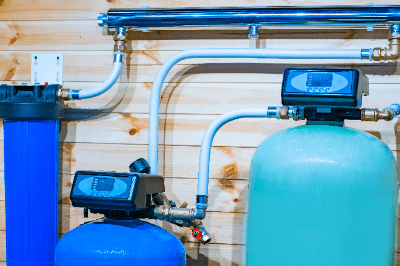What Is a Cartridge Water Purifier?
 A cartridge water purifier is a device that can easily purify water by simply connecting it to a water tap.
A cartridge water purifier is a device that can easily purify water by simply connecting it to a water tap.
The installation of a DI water purifier does not require complicated construction, so the hurdle for installation is very low. Activated carbon pretreatment filters and ion exchange resins are used to purify pure water by removing impurities such as iron, manganese, and calcium contained in the water supply.
These filters and resins need to be replaced periodically, but because they are cartridge-type, they can be replaced with a simple operation. Because they are thus very easy to handle, they are used in research facilities and general households.
Uses of Cartridge Water Purifiers
Cartridge water purifiers are used to purify tap water by removing impurities such as iron, chlorine, and calcium.
Mainly in research facilities, the use of pure water is a prerequisite because tap water containing impurities cannot be used for experiments and research. In the home, demand has recently been increasing for use in automobile cleaning and humidifier applications.
However, cartridge water purifiers are often relatively large and require a smaller capacity. Pure water is not suitable for beverage use, as mineral components and impurities have been removed.
Principle of Cartridge Water Purifiers
This section describes the purification principle of cartridge water purifiers. Basically, purified water is purified through two steps: a pretreatment filter and an ion exchange resin.
1. Pre-Treatment Filter
The pre-treatment filter is also called an activated charcoal filter, and its role is to remove residual chlorine from tap water. Porous charcoal is built into the filter and adsorbs particulates by attraction. Impurities are removed by entering the pores on the surface, and as the number of pores decreases, the removal performance declines.
This pretreatment is necessary because chlorine is a factor that degrades ion exchange resins. It is sold as a set with a cartridge water purifier, and there is no need to be specially concerned about it.
However, the chlorine capacity that can be adsorbed is fixed, so periodic replacement is essential.
2. Ion Exchange Resin
Ion exchange resins are made of synthetic resins. There are two types: cation exchange resins and anion exchange resins.
Cation exchange resins absorb calcium ions from tap water, while anion exchange resins adsorb sulfate ions and other ions. In doing so, the originally retained hydrogen and hydroxide ions are released to form water.
There is a limit to the use of this resin as well, and if a certain exchange capacity is exceeded, performance degradation will occur.
The above two steps are used to purify pure water, but care must be taken because, if used incorrectly, the filter and resin will become clogged or deteriorated, rendering them unusable.
Other Information on Cartridge Water Purifiers
1. Relationship With Semiconductor Demand
Cartridge water purifiers are used in the manufacture of semiconductors and precision equipment, and as demand for these products grows, so does the demand for cartridge water purifiers. The use of pure water is absolutely necessary for cleaning during the manufacturing process, and water containing impurities cannot be used.
Impurities that remain after drying can have a negative impact, and are a major factor in the quality of precision equipment.
2. Improved Replacement Frequency
Both activated carbon filters and ion exchange resins have a limit to their use and need to be replaced periodically. In many cases, this replacement becomes a burden during continuous use, and reducing the frequency of replacement is an issue. The next idea is to distribute the respective burdens by RO filtration in advance.
However, since this requires additional processes and equipment, a drastic review is also important. Currently, chemical treatment of activated carbon to increase the number of surface pores is being investigated. This is expected to increase the capacity and extend the service life of a single removal, and is also expected to improve the removal performance itself.
3. Regeneration of Ion Exchange Resins
The ion exchange resin used in the process of purifying water retains ions that are different from those initially present. By treating the resin to release these ions, it can be reused.
Cation exchange resins are immersed in dilute hydrochloric acid or dilute sulfuric acid, and anion exchange resins are immersed in a sodium hydroxide solution. A reversible reaction of ion exchange occurs, and regeneration can be realized.